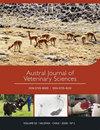Aquatic pollution from anthropogenic discharges modulates gene expression in liver of rainbow trout (Oncorhynchus mykiss)
IF 0.8
4区 农林科学
Q3 VETERINARY SCIENCES
引用次数: 0
Abstract
With the aim to characterise the biological impact of anthropogenic discharge in a river, gene expression in fish was evaluated as a biomarker for mixture effects of potential toxic compounds in the aquatic environment. Adult male rainbow trout (Oncorhynchus mykiss) were used as monitoring organisms. Within the German experimental set up, trout were exposed actively for 28 days in biologically purified sewage as well as in river water up- and downstream of the sewage treatment plant (STP) effluent. In a different approach, wild trout were captured in southern Chile near anthropogenic discharges. Fish were taken from river Maullin receiving sewage from a settlement and from river Pescado influenced by effluents from a fish farm. In vivo effects were assessed by RT-qPCR analyses of biomarker gene expression, vitellogenin (vg), metallothionein (mt) and cytochrome 1A (cyp1A) in liver samples with primers amplifying specific sequences previously confirmed by cloning and sequencing. The modulation of expression of marker genes involved in metal stress, reproduction and detoxifying systems in the liver of male rainbow trout revealed organismal response to anthropogenic contamination in two different study areas, such as Chile and Germany, thereby indicating a potential risk on the aquatic ecosystems.人为排放的水生污染调节虹鳟肝脏中的基因表达
为了表征河流中人为排放的生物影响,鱼类的基因表达被评估为水生环境中潜在有毒化合物混合影响的生物标志物。成年雄性虹鳟(Oncorhynchus mykiss)被用作监测生物。在德国的实验装置中,鳟鱼在生物净化的污水以及污水处理厂(STP)上游和下游的河水中积极暴露28天。另一种方法是,在智利南部靠近人为排放的地方捕获野生鳟鱼。鱼是从Maullin河和Pescado河中采集的,Maullin河水接收来自一个定居点的污水,Pescado河水受到养鱼场废水的影响。通过RT-qPCR分析肝脏样品中的生物标志物基因表达、卵黄蛋白原(vg)、金属硫蛋白(mt)和细胞色素1A(cyp1A),用扩增先前通过克隆和测序确认的特定序列的引物来评估体内效应。在智利和德国等两个不同的研究地区,参与雄性虹鳟肝脏金属胁迫、繁殖和解毒系统的标记基因表达的调节揭示了生物体对人为污染的反应,从而表明对水生生态系统的潜在风险。
本文章由计算机程序翻译,如有差异,请以英文原文为准。
求助全文
约1分钟内获得全文
求助全文
来源期刊

Austral Journal of Veterinary Sciences
Veterinary-General Veterinary
CiteScore
1.60
自引率
0.00%
发文量
18
期刊介绍:
Austral Journal of Veterinary Sciences (formerly Archivos de Medicina Veterinaria) publishes original scientific contributions in English, containing the latest developments and discoveries in veterinary sciences. The journal covers topics such as animal health and production, preventive medicine, zoonosis, pharmacology and therapeutics, methods of diagnosis, and other areas related to the veterinary field.
Austral Journal of Veterinary Sciences aims to divulge information about advances in veterinary medicine among universities, research centres, industries, government agencies, biologists, agronomists and veterinarians.
 求助内容:
求助内容: 应助结果提醒方式:
应助结果提醒方式:


